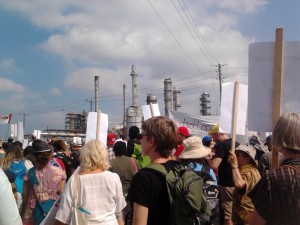By the Rev. Maggie Helwig
An eagle hovers over the intersection as we gather. Around us, high smokestacks, overhead pipelines, huge corroded storage drums – the landscape of an industrial wasteland, Canada’s “Chemical Valley.”
Home to 40 per cent of Ontario’s petrochemical industry, with more than 60 major industrial facilities concentrated in one small area, Chemical Valley, near Sarnia, is also situated directly beside the Aamjiwnaang First Nation Reserve, and it is the youth of Aamjiwnaang who have taken the lead in organizing today’s Toxic Tour. Lindsay Beze Gray, an extraordinary young activist, tell us what it is like to live in a community where chemical spills and the blare of warning sirens are part of everyday life, where whole classes of children are sent home from daycare with rashes and burning eyes, and where rare cancers are frequent causes of death.

There are few more obvious examples of what Bishop Mark MacDonald, writing in the Anglican Journal, has called the “second phase of colonization … vast economic, cultural and environmental control.” Aamjiwnaang residents have had no choice about the industries eating up the land all around them; but they are acting now to protect their people, their culture and their land, and part of the responsibility of the church in restoring right relationship is to walk with them. So we have come today to do that, for a very short time, in the literal sense; nearly 500 people, we estimate, have journeyed from Toronto, Hamilton, Ottawa, Montreal, Kitchener-Waterloo and elsewhere. Most of them are young activists, but there are also families with small children, some older people, some walking with difficulty. Anglican, United, Mennonite and Roman Catholic congregations are represented. “We were driving along the river on our way here,” says Alicia Good, a Mennonite pastor in North Leamington, “and we got to those industrial plants, discharging into the river, and we realized that river flows into our lake. This is our water, too.”
Through smothering humidity and scorching sun, during the world’s hottest summer ever recorded, we pass facilities belonging to Suncor, Hydro One, Dow Chemicals; we pass huge gravel pits and towering chimneys. Lindsay tells us that Aamjiwnaang residents are used to constant flares from these chimneys, and that they hardly pay attention to the sirens any more.
Between the Styrolution facility and the Cyeco facility, near where the village of Blue Water used to be, where a historical plaque commemorates its now-erased existence, Kelly Kiyoshk of the Aamjiwnaang community gets onto the back of a flatbed truck to speak. “I wasn’t expecting to say anything today,” he tells us, but then delivers one of the most eloquent speeches of the day. “These plants, these animals – they’re still carrying on the way we’re meant to carry on. The laws of creation haven’t changed.” It is still possible to see that this could have been a beautiful area, and that it could be again. “I feel sorry for white people,” Kelly goes on. “I mean, what can you do with your lives? The economy controls everything. You have to pay to live on the Earth. Think about that. We’re the only species that has to pay to live on the Earth. We have a very big crisis, we have a very big change to make. I don’t know what’s going to happen for these kids if we don’t. And what it’s going to take is us here, all of us. We not only have to learn to stand up, we have to learn to be kind to each other, to share with each other. That’s what the Creator gave us. If we do that, we can do more than build a movement. We can create a life.”
The Toxic Tour is neither the beginning nor the end of the work in Aamjiwnaang. Lindsay and her sister Vanessa, with assistance from some settler activists in Sarnia and elsewhere, are spearheading a project of comprehensive soil and water testing, something no company or government has yet been willing to do; they and others are involved in the campaign against the reversal of Enbridge’s Line 9, which runs by their community and will, if Enbridge has its way, soon carry highly toxic and corrosive diluted bitumen from the tar sands. This February, a group of Aamjiwnaang residents filed a suit against Shell for a documented 2013 spill which released mercaptan, benzene and hydrogen sulfide, making many of the children in the daycare ill and potentially causing long-term effects that won’t be visible for years.
But we cannot leave this struggle to the community alone. As Bishop Mark MacDonald reminds us, “We now see human culture organized toward a new Tower of Babel, a denial not only of God’s design, but in its moral presumption – that economic life rules all other life – a denial of the sovereignty of God. We cannot tolerate a faith that calls itself Christian and separates our salvation, our morality and our world, a faith that is silent in the face of such injustice.” The Toxic Tour was one small act of solidarity, one small way of recalling ourselves to our responsibilities. There must be many more.
The Rev. Maggie Helwig is the incumbent of St. Stephen in-the-Fields, Toronto.